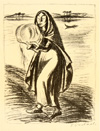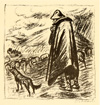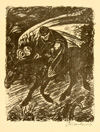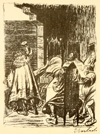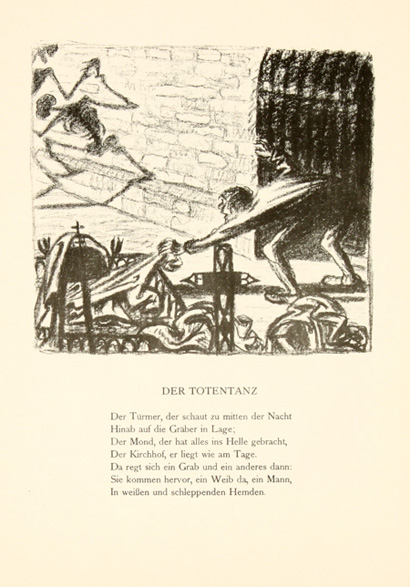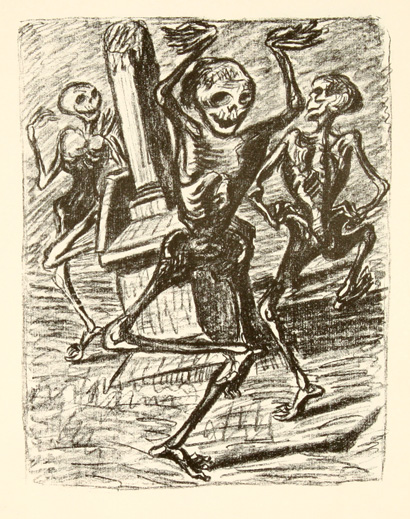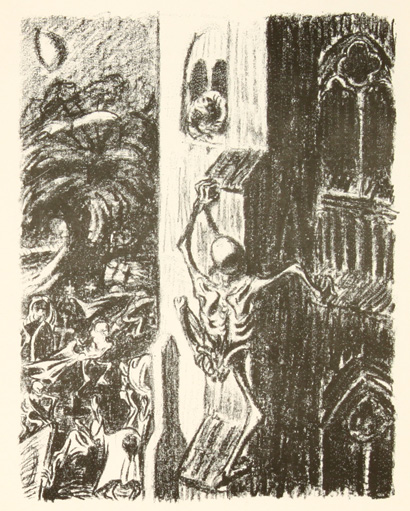< Back to Art Books
< Previous Next >
Ernst Barlach: Goethe Gedichte Mit Steinzeichnungen - 1970 Reprint Edition of Barlach Lithographs for Goethe Poems
***
Ernst Barlach (1870-1938), a great sculptor, printmaker, illustrator, graphic artist and playwright, was strongly moved by Goethe's literary works and dedicated many of his artistic creations to interpreting Johann Wolfgang von Goethe's plays and poems. Berlach, a talented writer by himself, wrote: "In general, I do not read much; however, Goethe's works capture me over and over again..." and indeed this preoccupation with Goethe's writings and metaphysical world, was an important thread which ran through Barlach's entire work for all his life.
In 1924, Barlach prepared a series of
35 lithograph illustrations to selected
poems of Goethe as part of a project initiated by
Paul Cassirer's publishing
house which was dedicated to Goethe's poems. The copy presented here, is the
first facsimile reprint edition of the original 1924 edition published in 1970
by the Rembrandt Verlag Berlin and is accompanied with a text by Elmar Jansen
Graphiische Zyklen und Illustrationen im Werk Ernst Barlachs - Graphic
cycles and illustrations in the work of Ernst Barlach.
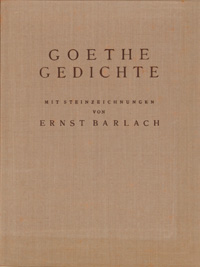
The front side of the cover of the slipcase with Goethe Gedichte Mit Steinzeichnungen von
Ernst Barlach.
ארנסט ברלך Ernst Barlach, אחד מן הפסלים החשובים של תחילת המאה העשרים, היה חלק מגרעין האמנים שהובילו את תנועת האקפרסיוניזם הגרמני. כרבים מאמני תקופתו, פעל ברלך במספר תחומים אחרים בנוסף על פיסול. הוא פרסם רומן - Der Gestohlene Mond, שמונה מחזות, שירים וספר אוטוביוגרפי, ובעיקר התמחה באמנויות ההדפס שהיוו בשבילו כלי ביטוי ישיר שבאמצעותו הגיע לקהל רחב. בהדפסי האבן ובחיתוכי העץ המופלאים שיצר, שילב ברלך באופן דרמטי, אלמנטים מן המסורת הגותית הגרמנית המאוחרת עם מוטיבים אמנותיים קדומים ספוגי חרדה וספיריטואליזם.
מרבים לספר על נקודת המפנה בהתפתחותו של ברלך כאמן לאחר ביקורו ברוסיה ב-1906. ברלך הושפע מאורח החיים והענווה של האיכרים ופשוטי העם הרוסיים שפגש, התעמק בכתביהם של טולסטוי ודוסטוייבסקי וביטא את מה שראה וחש בסדרה של פסלי דמויות שמקרינים בתמציתיות את הרגשות הבסיסיים של האדם - בדידות, פגיעות וחוסר ישע אל מול המיסתורין האלוהי הקוסמי.
מוקד נוסף בעולמו הפנימי של ארנסט ברלך היו כתביו של יוהאן וולפגנג פון גתה שבהם חזר ברלך וקרא ושאליהם התייחס לאורך כל שלבי יצירתו האמנותית. הרגשנות, הרומנטיקה, העצמה הדרמטית וההקשר הקלאסיציטי של גתה, שבו את ליבו של ברלך כמו גם העיסוק של גתה בכאב, ביסורים האנושיים ובמוות. מארז הקופסא המוצג פה לפניכם, שהוצא לאור בשנת 1970 בברלין, כולל 35 ליטוגרפיות שהן העתק מאושר של ההוצאה הראשונה משנת 1924 של "שירים של גתה עם ליתוגרפיות של ארנסט ברלך" Goethe Gedichte Mit Steinzeichnungen von Ernst Barlach. הליטוגרפיות שנוצרו ע"י ברלך עבור שירים נבחרים של גתה, משקפות בצורה מושלמת את החיבור רב ההשראה בין עצמת הביטוי החזותי של ברלך לפסגת השירה של גתה.
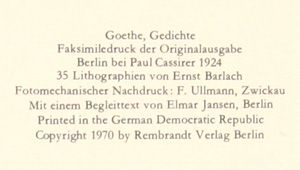
35 lithographs by Ernst Barlach for Goethe's poems
![]()
35 lithographs by Ernst Barlach for Goethe's poems - Facsimile of the original edition of Paul Cassirer in Berlin 1924 - Printed in the Democratic Republic of Deutschland, 1970 - by Rembrandt Verlag Berlin
Barlach's illustrations combined with the texts of some of the best and most famous poems and ballads of Goethe, were printed on loose sheets of quality paper (39.5 cm x 29 cm) and packed in a brown cloth slipcase cassette (see picture above) which is an authentic facsimile of the original 1924 edition slipcase.
Just as in Paul Cassirer's edition, additional 16 stand-alone high quality plates of arlach's lithographs, printed with a slightly more ochre background color, were also added to the box package. These plates are beautiful and some of them include motives that are not part of the sheets with the illustrations to the poems. The rational of Paul Cassirer's publishers for adding these 16 stand-alone plates, was that collectors may be able to pick up their favorite illustrations and frame them with passe-partout. The full size picture portion of each of the stand-alone sheets is displayed here according to the original sequence in the book:
Barlach's approach to illustrating Goethe's poems, was quite different from the powerful archaic style, full of spiritualism and angst which he used in his former portfolio of 20 woodcuts for Goethe's Walpurgisnacht - Walpurgis Night which was published in 1923, also in Paul Cassirer's publishing house. In the illustrations to Goethe's poems and ballads, Barlach restrained some of his renowned dramatic intensity, and became more affable, soft and tender, deeply inspired by Goethe's "With the multi-colored morning / You smile to him in your heart…" mood. Yet all these illustrations, although so ft and gentle, are still absorbed with Barlach's typical mystic way of observation and convey a soaring feeling of legend and beauty.
There is one exception to the relatively countryside pastoral atmosphere which characterizes Barlach's approach to illustrating Goethe's poems - the presentation of Barlach to Goethe's poem Der Totentanz - The Dance of Death:
Der Totentanz 1 (Das Totenlaken) - The Dance of Death 1 (The Shroud) by Ernst Barlach
In a series of illustrations dedicated to Goethe's Der Totentanz and Das Totenlaken poems, Barlach expresses some of his old favorite themes: death, the dramatic tension between mysticism and morbidity and the spiritual struggle which accompanies real life.
|
Der Totentanz - The Dance of Death
English by Edgar Alfred Bowring |
|
The warder looks down at the mid hour of night, |
Der Totentanz 2 (Drei tanzende Gerippe) - The Dance of Death 2 (Three Dancing Skeletons) by Ernst Barlach
בעוד שמרבית שותפיו של ארנסט ברלך לזרם האקספרסיוניזם הגרמני נטו לכוון פרובוקטיבי, לעיתים אבסטרקטי וחלמו על השפעה פוליטית ישירה, שמר ברלך על ביטוי אמנותי פשוט וטהור שבמרכזו דמות האדם הארכאי שסימל עבורו את משמעות הקיום האנושי - חוסר ישע בסיסי שאין לו מענה בתפיסת העולם הרציונאלית והמדעית האופיינית לעת המודרנית. הדמויות של ברלך שקטות, שבירות, שקועות בעצמן,מנותקות, כאלו שפסעו הצידה בעולם מאיץ ומדרדר - ירדו או הורדו מן הרכבת שלא ברצונן.
Der Totentanz 3 (Verfolger Tod) - The Dance of Death 3 (Pursuer's Death) by Ernst Barlach
כאשר פרצה מלחמת העולם הראשונה, נתקף ברלך בפרץ פטריוטיות והתגייס לצבא הגרמני אך לאחר שירות של מספר חודשים ומפגש קרוב עם מכונת המלחמה הפך לפציפיסט וסרבן ושוחרר מן השירות. בשנים שלאחר המלחמה הקים ברלך מספר אנדרטאות המנציחות את מוראותיה שהמפורסמת בהן היא זו שהוצבה בקתדרלה של מגדנבורג Magdeburg Cathedral. אמו, אליה היה קשור מאד, סבלה מדיכאון התאבדה ב-1920 וחייו, כפי שהתבטאו ביצירתו הספרותית ובעלילות המחזות שחיבר, היו ספוגים כנראה בסבל אישי לא מבוטל. אך למרות זאת, בתחום האמנותי, זכה ברלך להצלחה ולפופולריות ניכרת, הרבה בזכות סדרות ההדפסים והרישומים המשובחות שפרסם.
עליית הנאצים לשלטון שנתה את פני הדברים. במנשר רשמי שפרסמה המפלגה הנאצית ב-1933 נאמר: יש להסיר מיד פסלים המוצבים במקומות ציבוריים ופוגעים ברגשות הלאומיים של העם הגרמני אפילו אם נוצרו על ידי "גאונים" כמו להמברוק Lehmbruck וברלך Barlach
ב-1937 הוחרמו עבודותיו של ברלך והוכנסו לרשימת "יצירות אמנות מנוונת", הוא אולץ
להתפטר (יחד עם תלמידתו
קטה קולביץ) ממשרתו כפרופסור ומורה באקדמיה האמנותית של
ברלין ונאסר עליו לעסוק באמנות ולפרסם. זמן קצר אחר כך ב-1938 נפטר ברלך בבידוד
ובבדידות.
As of the beginning of the 20s, Ernst Barlach was considered one of the leading German Expressionist artists. He became a member of the Prussian Art Academy, and received the Kleist Price for Drama. In 1933 he was awarded the Prussian Order of Merit.
After the rise of the Nazis, his artistic work was seen as subversive and Barlach "joined" the group of talented artists which were denounced by Hitler as "the spoilers of art who belong in an insane asylum or a prison" together with Paul Klee, Emil Nolde, Max Beckmann, Ernst Ludwig Kirchner, Otto Dix, George Grosz, Wassily Kandinsky, Oskar Kokoschka, and many other German and non-German artists, such as Marc Chagall.
Barlach was forced to resign from the Prussian Academy of Arts together with Kathe Kollwitz whom he taught the craftsmanship of woodcutting. Many of Barlach's sculptures and war memorials were removed from German museums, his books were not published, and in 1937 his works were included in the notorious "Degenerate Art" exhibition. Additionally he was banned from working as a sculptor, while his membership in the Berlin Academy of Fine Arts was cancelled.
In a letter to a friend Barlach wrote that the "nationalist terror will probably outlast me". He died soon after, in 1938.
Slipcase cassette: 35 lithographs
combined with text of Goethe's poems + 16 stand-alone lithographs - all printed
on loose sheets of quality paper (39.5 cm x 29 cm) and packed in a brown cloth
slipcase cassette
Publisher: Rembrandt Verlag, Berlin; 1st reprint edition (1970) -
accurate facsimile of the original 1924 edition
Language: German - introduction by Elmar Jansen.
Price: $Call
References:
Kathe Kollwitz - I saw the world with loving eyes by Hans
Kollwitz - Deluxe Edition with Original Etching
© Dan Levy - Art Pane Home of Art Books
< Back to Art Books
< Previous Next >




